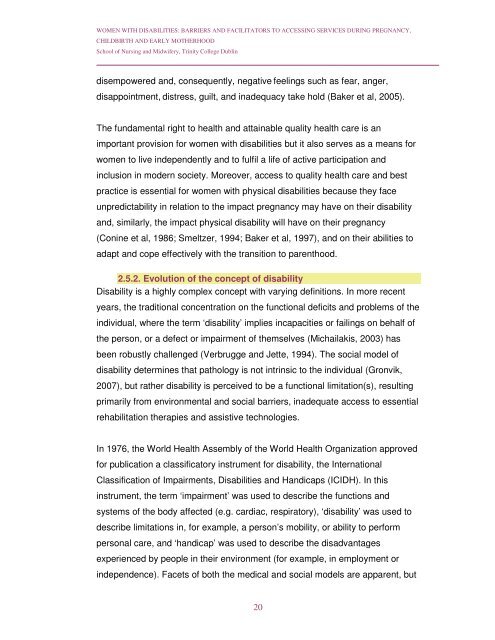Women with Disabilities: Barriers and Facilitators to Accessing ...
Women with Disabilities: Barriers and Facilitators to Accessing ...
Women with Disabilities: Barriers and Facilitators to Accessing ...
You also want an ePaper? Increase the reach of your titles
YUMPU automatically turns print PDFs into web optimized ePapers that Google loves.
WOMEN WITH DISABILITIES: BARRIERS AND FACILITATORS TO ACCESSING SERVICES DURING PREGNANCY,CHILDBIRTH AND EARLY MOTHERHOODSchool of Nursing <strong>and</strong> Midwifery, Trinity College Dublindisempowered <strong>and</strong>, consequently, negative feelings such as fear, anger,disappointment, distress, guilt, <strong>and</strong> inadequacy take hold (Baker et al, 2005).The fundamental right <strong>to</strong> health <strong>and</strong> attainable quality health care is animportant provision for women <strong>with</strong> disabilities but it also serves as a means forwomen <strong>to</strong> live independently <strong>and</strong> <strong>to</strong> fulfil a life of active participation <strong>and</strong>inclusion in modern society. Moreover, access <strong>to</strong> quality health care <strong>and</strong> bestpractice is essential for women <strong>with</strong> physical disabilities because they faceunpredictability in relation <strong>to</strong> the impact pregnancy may have on their disability<strong>and</strong>, similarly, the impact physical disability will have on their pregnancy(Conine et al, 1986; Smeltzer, 1994; Baker et al, 1997), <strong>and</strong> on their abilities <strong>to</strong>adapt <strong>and</strong> cope effectively <strong>with</strong> the transition <strong>to</strong> parenthood.2.5.2. Evolution of the concept of disabilityDisability is a highly complex concept <strong>with</strong> varying definitions. In more recentyears, the traditional concentration on the functional deficits <strong>and</strong> problems of theindividual, where the term ‘disability’ implies incapacities or failings on behalf ofthe person, or a defect or impairment of themselves (Michailakis, 2003) hasbeen robustly challenged (Verbrugge <strong>and</strong> Jette, 1994). The social model ofdisability determines that pathology is not intrinsic <strong>to</strong> the individual (Gronvik,2007), but rather disability is perceived <strong>to</strong> be a functional limitation(s), resultingprimarily from environmental <strong>and</strong> social barriers, inadequate access <strong>to</strong> essentialrehabilitation therapies <strong>and</strong> assistive technologies.In 1976, the World Health Assembly of the World Health Organization approvedfor publication a classifica<strong>to</strong>ry instrument for disability, the InternationalClassification of Impairments, <strong>Disabilities</strong> <strong>and</strong> H<strong>and</strong>icaps (ICIDH). In thisinstrument, the term ‘impairment’ was used <strong>to</strong> describe the functions <strong>and</strong>systems of the body affected (e.g. cardiac, respira<strong>to</strong>ry), ‘disability’ was used <strong>to</strong>describe limitations in, for example, a person’s mobility, or ability <strong>to</strong> performpersonal care, <strong>and</strong> ‘h<strong>and</strong>icap’ was used <strong>to</strong> describe the disadvantagesexperienced by people in their environment (for example, in employment orindependence). Facets of both the medical <strong>and</strong> social models are apparent, but20
















